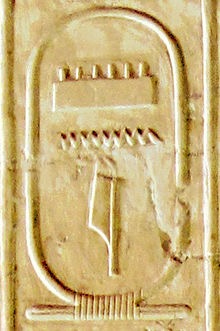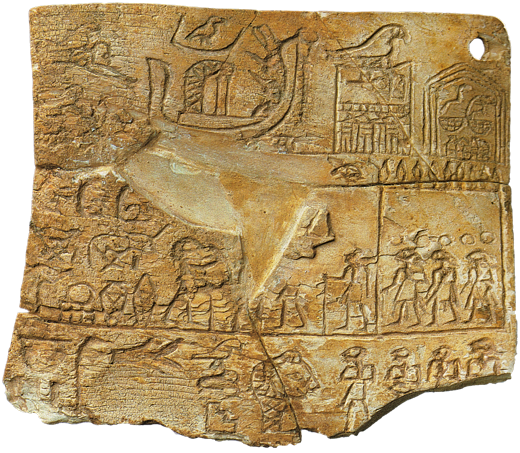
Cartouche of Meni (Menes) from the king-list in the temple of Seti I at Abydos.
According to the Ancient Egyptians themselves, the first king to have ruled over the whole of the country, was named Meni, or, in Greek, Menes. This is voiced through several king-lists, by the Greek traveler Herodotos and by Manetho.
The Turin King-List mentions Menes after a long list of gods and demi-gods who ruled the country before, making him the first human king of Egypt.
Menes is credited with a great, many deeds, such as the unification of Upper and Lower Egypt through the conquest of the Nile Delta and founding the capital of Memphis on the border between the two parts of the country.
Unfortunately, the archeological record dated to the time when this Menes would have lived, does not mention a king with this name. This is due to the fact that the king-lists provide what was possibly the kings’ private names, whereas during the Early Dynastic Period, kings were identified by their Horus Name. It is only from the reign of Horus Djer on, that we have sources that seem to combine both names.
From early on in the history of Egyptology, the debate about the identification of Menes with one of the archaeologically attested kings centred around two kings: Horus Narmer and Horus Aha.
The name “Menes”
As stated in the introduction of this page, there is no source that unambiguously links the name of Menes to any archaeologically attested king. There are, however, two sources that do display a sign that can be read as mn in connection with the names of Narmer as well as Aha.
Drawing of a seal that combines the name of Narmer with a sign that can be read as mn.
Source: Kaplony, Inschriften der ägyptischen Frühzeit III, Tafel 28, Abb. 77.
The oldest source is a seal impression of the name of Narmer followed by the hieroglyphic sign mn. While some Egyptologists have interpreted this source as providing Narmer’s birth name, Men and thus as proof that Menes is to be identified with Narmer, others have pointed out that for similar seals dated to Aha, the name of the king is combined with different other names. This would mean that the signs that accompany the kings’ names on these seal impressions refer to different people and thus not to the king.
Based on the unfounded assumption that all the high officials of this period were members of the royal family, it has been postulated that the names on these seal impressions belonged to sons of the kings. The Men mentioned on the seal with Narmer would thus be a son of Narmer’s, making Menes the successor of Narmer, Aha.
Against this it must be pointed out that there is no evidence that high officials were relatives of the king, let alone that they had to be his sons.
The second source that has been interpreted as connecting Menes to a Horus Name, is the Naqada Label, dated to the reign of Aha. The top part of the label shows the Horus Name of Aha facing as what some have interpreted to be a Nebti Name, and more specifically, a Nebti Name read as Men. Following this interpretation the Naqada Label would thus provide the Nebti Name of Menes.
Some Egyptologists have wanted to see a direct link between the Horus Name and the assumed Nebti Name and have taken the Naqada Label as evidence that Men was the birthname of Aha. Others, however, are of the opinion that the label represents the visit of Aha to a shrine dedicated to a king with the Nebti Name Men, making Men a predecessor of Aha.

The Naqada Label seems to represent a visit to a shrine dedicated to the patron goddesses of Upper and Lower Egypt by Horus Aha. The shrine is sometimes seen as the king’s Nebti name, which would identify him with the near-legendary Menes, rather than his predecessor Narmer.
Source: Tiradriti, Egyptian Treasures, p. 42.
It has also been proposed that the alleged Nebti Name on the label is no Nebti Name at all, but part of the name of a shrine dedicated to the Nebti, the Two Ladies, Nekhbet and Uto. If this is the case, then the Naqada label may have no bearing at all on the Menes debate.
The Unification of Upper and Lower Egypt
The Narmer Palette has played an important role in the Menes debate.
Although Menes is credited with the unification of Upper and Lower Egypt, there are several sources that show that even before the times of Narmer and Aha, large parts of Egypt where under the control of one central authority. The names of two presumed predecessors of Narmer, Horus Ka and Horus Mouth, have been found in parts of Upper as well as in Lower Egypt.
Nevertheless, the Narmer Palette and a label dated to Narmer’s reign, point to this king having held a military campaign in a marshy region -perhaps in the Nile Delta- and probably having founded a province in the Nile Delta. Many Egyptologists have seen the Narmer Palette as evidence of the conquest of Lower Egypt by and Upper Egyptian king, and have thus equated Narmer to the almost legendary Menes.
An additional argument that was used to link Narmer to the unification of Upper and Lower Egypt, is that the Narmer Palette may be the oldest known object showing the same king wearing the White and the Red Crowns. Although later tradition would associate these crowns with Upper and Lower Egypt respectively, it is not clear whether this was already the case in Narmer’s time. It is more likely that at the start of the Early Dynastic Period, both crowns represented specific aspects of royal power rather than different regions in the kingdom.
But even if the two crowns initially did not have their geographical meaning, the Egyptian chroniclers who later identified Menes as their first king, did make that connection and to them, an object like the Narmer Palette, may still have been proof of the unification of Upper and Lower Egypt by Narmer.
The founding of Memphis
That Menes is said to have founded Memphis, is often linked with the appearance of impressive mastaba tombs for the nobility at Saqqara North, part of the Memphite Necropolis. As the oldest of these mastabas, probably belonging to a high official who went by the name of Heti, is dated to the reign of Aha, this is seen as an indication that Aha founded Memphis.
Against this view it must be pointed out that there are also traces of Narmer at Saqqara and that it would be very unlikely there would not have been a major city located right where the Nile divides into arms of the Nile Delta, prior to Aha. Or, for that matter, prior to Narmer.
What is more likely is that Menes, regardless of his identification with either Narmer or Aha, turned an existing city into one of the county’s capitals, most likely by building a palace or at least a royal estate through which the region’s administration was handled.
One of the oldest names of Memphis was Ineb-Hedj, often translated as “The White Wall(s)”, a name believed to have been a reference to the walls that surrounded the city.
A seal impression found in the Memphite region, shows the name of Narmer written within a rectangular enclosure linked to a mace. The hieroglyph representing a mace is read HD. Connected to the enclosure, the reading of the group becomes inb HD, Ineb-Hedj. Perhaps initially a fortress or a palace built by Narmer, Ineb Hedj would become one of the names of the city where it was built and thus confirms Narmer’s presence in and importance to Memphis.

Drawing of a seal impression that combines Narmer’s name with signs that represent a wall (square) and a mace, and that could be read as the ancient name of Memphis.
Source: Kaplony, Inschriften der ägyptischen Frühzeit, Band III, Tafel 18, abb. 34.
A closer look at the king-lists and the Umm el-Qa’ab seals
According to Cairo Fragment CF1 of the Annals Stone, the birthname of Horus Djer was Iti. This name corresponds with the name of the third king on the king-lists, meaning that there was one king between Djer and Menes.
Proponents of the identification of Aha with Menes have therefor postulated that there was a very brief reign between Aha and Djer, so brief not to have left any archaeological traces, yet still accounted for in the king-lists. Cairo Fragment CF1 appears to have recorded a gap of 1 month and 15 days between the end of the previous reign and the start of Djer’s. This has been seen as confirmation of a 45-day reign of an otherwise ephemeral king between Aha and Djer, which would identify Menes with Aha. Without any other sources, and preferably contemporary ones, to confirm that there was a brief reign between Aha’s and Djer’s, it is, however, much more likely that the 45 day discrepancy was the result of either the time it took for Djer to fully assume office and be crowned, or of a scribal error.
Two seals, known through the impressions they left, of the royal cemetery of Umm el-Qa’ab, list some of the kings buried at that site. The oldest seal lists all kings from Narmer to Den in chronological order. The list ends with the name of the Queen-Mother Merneith, Den’s mother who was regent of Egypt during the early years of Den’s reign. Each royal name is separated from the next by the name of Khentamenti, the god of the dead, who also starts the list.
The second seal is dated to the reign of Qa’a. It starts with Khentamenti and then lists all the kings from Qa’a to Narmer, in reversed chronological order.

Seal impression listing the kings buried at Umm el-Qa’ab, listing, from left to right: Khentamentiu (the protector-god of the necropolis), Qa’a, Semerkhet, Anedjib, Den, Djet, Djer, Aha and Narmer.
Source: Dreyer, Ein Siegel der frühzeitlichen Köningsnekropole van Abydos, in MDAIK 43 (1986)
Sorted chronologically and omitting Khentamenti, both seals have Narmer as the oldest king. Narmer’s predecessors, Horus Ka and Horus Mouth are missing, either because they had been forgotten or because the makers of the seals did not consider them to belong to this list.
In both seals, Djer is the third king in the row, immediately following Aha. There is no otherwise unattested king in between them, as there is also no royal tomb that could be dated between these two kings.
The most recent seal lists 8 kings, ending with Qa’a. Manetho’s 1st Dynasty has 8 kings, also ending with Qa’a. The seal lists the kings in the same order of succession as the first 8 kings of the king-lists.
Conclusion
Despite the scanty amount of sources and the multiple interpretations possible for most of them, the Umm el-Qa’ab seals, although they were not intended as a king-list but rather as a list of gods present at the royal necropolis of Umm el-Qa’ab, put Narmer at the start of the list. As this list corresponds well with the first kings on the king-lists and with the kings in the 1st Dynasty, it is most likely that the almost legendary Menes, who, I am sure, has been credited with far more accomplishments than the historical Menes has done, is to be identified with Narmer.